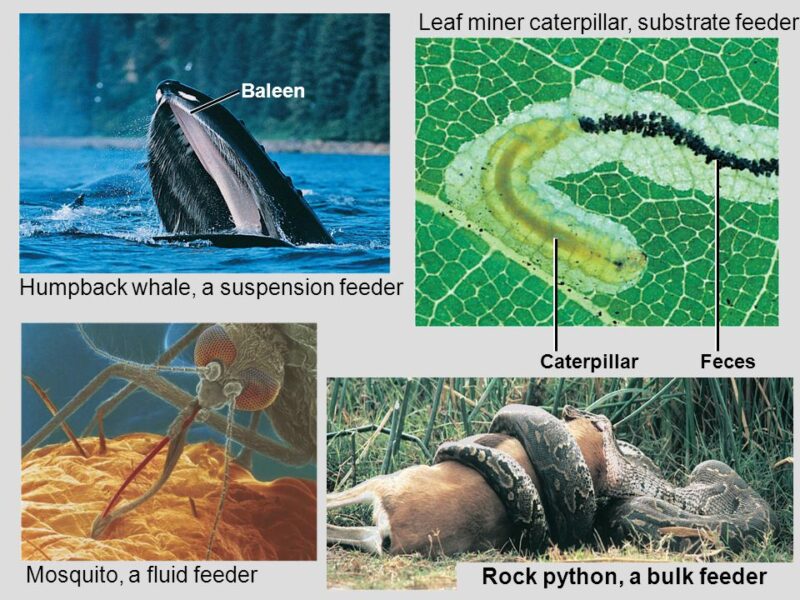Imagine sitting down to a meal, but instead of using forks and knives, you have to filter your food from the water, burrow through your meal, sip it through a straw, or swallow it whole. Sounds intriguing, right?
This is the daily reality for the animal kingdom, where dining is not just about eating but about surviving and thriving through ingenious methods honed by evolution. In this blog post, we’ll explore 4 main feeding mechanisms of animals.
Key Takeaways
- Animals employ four primary strategies to obtain food – filter feeding, substrate feeding, fluid feeding, and bulk feeding.
- Filter feeders, such as krill and blue whales, strain tiny food particles from water.
- Substrate feeders, like earthworms and caterpillars, live in or on their food source.
- Fluid feeders, including mosquitoes and hummingbirds, extract liquids from plants or animals.
- Bulk feeders consume large pieces of food.
| Feeding Mechanism | Examples | Mechanisms/Specialized Structures | Role in Ecosystem |
|---|---|---|---|
| Filter Feeding | Krill, Baleen whales, Sponges | Hair-like structures, Mucus, Baleen plates | Water purification, Supports marine food web |
| Substrate Feeding | Earthworms, Caterpillars, Termites | Burrowing through soil or decaying matter, Consuming leaves directly | Decomposition, Nutrient cycling |
| Fluid Feeding | Mosquitoes (blood), Hummingbirds (nectar), Butterflies (nectar) | Beaks, Proboscises for nectar; Piercing and sucking mouthparts for blood or sap | Pollination, Disease transmission |
| Bulk Feeding | Humans, Lions, Eagles, Snakes | Active hunting or foraging, Stalking, Pouncing, Grazing, Browsing | Maintaining predator-prey dynamics, Nutrient distribution |
1. Filter Feeding
Filter feeders are the ocean’s strainers, sifting through vast amounts of water to capture their microscopic meals. These animals, ranging from the smallest krill to the colossal blue whale, have specialized structures that allow them to filter out food particles from the water.
The mechanics of filter feeding vary among species, with some using hair-like structures to trap food, while others employ mucus and physical barriers. This method is not just about feeding; it’s a crucial ecological service that keeps water bodies clean and supports the marine food web.
2. Substrate Feeding
Substrate feeders are the burrowers and leaf-eaters, animals that live in or on their food sources. Earthworms and caterpillars are prime examples, consuming dead vegetation and leaves as they move through soil or across plants.
These creatures play a vital role in decomposition and nutrient cycling, breaking down organic matter and enriching the soil. Their feeding habits highlight the interconnectedness of life, turning decay into growth.
3. Fluid Feeding
Fluid feeders tap into the liquid essence of life, extracting nourishment from the fluids of plants and animals. This group includes creatures like mosquitoes and hummingbirds, each with specialized mouthparts to pierce, suck, or lap up their liquid diets.
Whether it’s nectar, blood, or sap, fluid feeders are adapted to a life of sipping the vital juices of other organisms, playing diverse roles in pollination, disease transmission, and ecosystem dynamics.
4. Bulk Feeding
Bulk feeders consume large pieces of food, embodying the image of eating that most of us are familiar with. This group includes humans, lions, and birds, among many others, who ingest significant portions of their prey or plants.
These animals have developed various hunting and foraging techniques, from stalking and pouncing to grazing and browsing. Bulk feeding illustrates the predator-prey relationships that are fundamental to ecological balance, showcasing the drama of life and death in the natural world.
FAQs
Can any animals switch between different feeding mechanisms?
Yes, some animals can switch between different feeding mechanisms depending on their life stage or available food sources. For example, many amphibians start life as filter feeders when they are tadpoles and then become bulk feeders as adults.
Are there any animals that use tools to help them feed?
Indeed, some animals use tools to aid in their feeding. For instance, sea otters use rocks to crack open shellfish, and some birds, like the Egyptian vulture, use rocks to break open ostrich eggs.
How do filter feeders avoid eating harmful substances along with their food?
Filter feeders have specialized structures and mucus that can trap food particles while allowing water and potentially harmful substances to pass through. Their filtering mechanisms are highly selective, ensuring they consume nutritious particles.
Do any animals practice communal feeding for efficiency?
Yes, several animal species engage in communal feeding to increase efficiency and success. For example, wolves hunt in packs to take down larger prey, and dolphins work together to herd fish into tight balls for easier feeding.
How do fluid feeders like mosquitoes find their food sources?
Fluid feeders like mosquitoes have sensory organs that detect carbon dioxide and body heat, which helps them locate warm-blooded animals to feed on. Some can also sense chemical signals emitted by their food sources.
Is there an animal that changes its feeding mechanism as it grows older?
Yes, the diet and feeding mechanism of some animals change as they grow. For example, a caterpillar (substrate feeder) will transform into a butterfly (fluid feeder), significantly changing its diet from leaves to nectar.
The Bottom Line
It’s clear that the ways animals feed are as varied and fascinating as the creatures themselves. From the microscopic filter feeders to the majestic bulk feeders, each strategy not only ensures survival but also contributes to the balance of ecosystems
Related Posts:
- Harmony in the Habitat: 5 Tips for Feeding Wild…
- What Are the Differences Between Mammals and Birds?…
- Why Do Rats Have Tails? These are the Three Main Purposes
- What Do Foxes Eat? Wild & Urban Fox Diet Info & Habits
- How Do Wild Horses Survive? - A Fascinating Study
- What Is the Difference Between a Coyote and a Wolf?…








